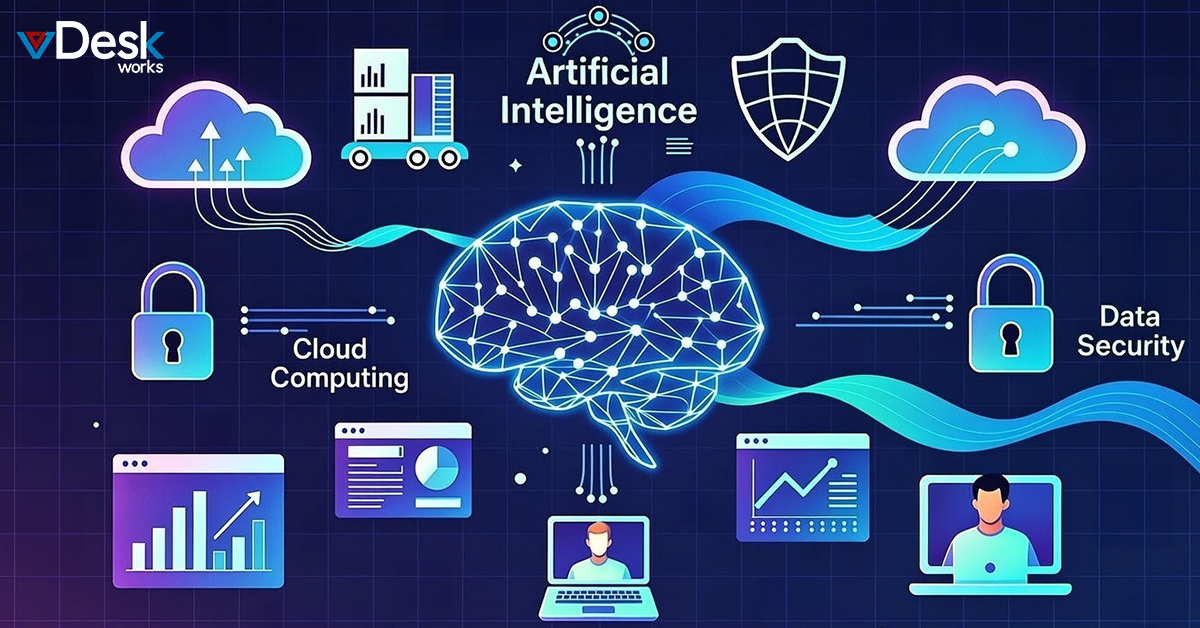In today's fast-paced and ever-changing corporate world, adopting technology innovations is critical to remaining competitive and efficient. The introduction of Virtual Desktops is one such innovation that has transformed the way businesses operate. These sophisticated technologies have not only streamlined office procedures, but also heralded a new era of automation, allowing organizations to fly to new heights.
The Ascension of Virtual Desktops
Traditional workplace arrangements with hefty technology and specialized workstations are a thing of the past. Virtual Desktops have emerged as a game changer for modern enterprises, providing a flexible, secure, and scalable option for remote access to desktop environments.
Virtual Desktops are powered by virtualization technology, which enables the development of many desktop instances from a single physical server. Each user may access their personalised desktop environment with apps, files, and settings, providing them with a consistent computing experience independent of the specifications of their equipment.
The Advantages of Virtual Desktops
Enhanced Security
By storing critical data on centralized servers, Virtual Desktops reduce the dangers of data breaches and physical theft. Companies can implement strict security processes and access controls to protect their essential information.
Employees can access their work environment from any internet-connected device, enabling remote work and increasing efficiency. This adaptability enables firms to access into a global talent pool while maintaining operations in the face of unforeseen challenges.
Cost-Efficiency
Virtual Desktops minimize the need for individual workstations by centralizing computing resources, saving hardware costs and energy consumption. Furthermore, software upgrades and installations may be managed centrally, saving time and resources.
Scalability
As a company grows, so does its need for computing resources. Virtual Desktops provide seamless scalability, allowing businesses to add or remove users and alter resources as needed.
IT Management Simplified: Centralized management of Virtual Desktops optimizes IT operations. IT teams can use a single console to monitor, debug, and update desktop instances, reducing downtime and increasing productivity.
Using Virtual Desktops to Increase Automation
Automation has become an essential component of modern business, simplifying repetitive processes and optimizing operations. Virtual Desktops are critical in enabling automation activities within an organization.
Automated Provisioning
With Virtual Desktops, setting up new workstations is a breeze. IT managers can automatically deploy standardised desktop instances, minimising the time and effort necessary for manual configurations.
Automated Updates
It is vital for security and performance to keep software and applications up to date. Automatic updates are enabled in virtual desktops, ensuring that users always have the most up-to-date features and patches without the need for manual involvement.
Backups that are automated
Data loss can be disastrous for any business. Virtual Desktops enable automated and regular backups, acting as a safety net in the event of an unforeseen event.
Automated Security Measures
Security procedures and access controls can be imposed automatically with Virtual Desktops. IT administrators may centrally configure security policies, lowering the chance of human mistake.
Selecting the Best Virtual Desktop Solution
Choosing the right Virtual Desktop solution is critical to realising its full potential and reaping the benefits it provides. When making this selection, several variables should be considered:
Performance must be evaluated by businesses to ensure that Virtual Desktop solutions fulfil the expectations of resource-intensive apps and workflows.
Security
To protect sensitive information, robust security measures such as data encryption, multi-factor authentication, and intrusion detection are required.
Scalability
As the organisation grows, the chosen Virtual Desktop solution should be able to scale to accommodate a rising number of users and workloads.
User Experience
An easy-to-use interface is critical for user adoption and overall productivity. An easy-to-use Virtual Desktop environment boosts employee happiness and shortens the learning curve.
Help and Maintenance
It is critical to have prompt and dependable technical help to address any issues that may develop during use. Furthermore, constant updates and maintenance guarantee that users have a consistent experience.
Top 4 Industries Using Virtual Desktops to Increase Workforce Efficiency
Virtual Desktops have broken down industry barriers, revolutionising the way firms function and manage their employees. Enterprises across all industries are leveraging the power of Virtual Desktops to boost productivity, improve security, and adapt to the changing needs of the digital age. Let's look at the top four sectors that have used Virtual Desktops to empower their employees and achieve a competitive advantage.
1. Medical care
The healthcare business prioritises patient data accessibility, secure communication, and efficient workflows. Virtual Desktops have developed as an important tool in this arena, allowing healthcare practitioners to access electronic health records (EHRs) and medical imaging apps from anywhere with an internet connection.
Whether at the hospital, clinic, or working remotely, physicians, nurses, and administrative staff may securely access patient data, collaborate in real-time, and offer timely care. Virtual Desktops' data centralization and strict security measures assure compliance with stringent healthcare standards, protecting sensitive patient information.
2. Banking and finance
Virtual Desktops are a perfect solution for financial and banking institutions in an industry where data security, compliance, and efficiency are critical. Financial professionals can safely access sensitive financial data, execute complicated financial simulations, and manage portfolios from anywhere with Virtual Desktops, without sacrificing security or performance.
Furthermore, the flexibility to expand resources in response to changing demand and regulatory constraints makes Virtual Desktops a cost-effective and agile option for financial institutions pursuing technological innovation.
3. Education
The education sector has seen a significant transition towards digital learning and distance education.
Virtual Desktops have been critical in enabling educational institutions to deliver a seamless virtual learning environment to students and educators. Regardless of their geographical location, educational institutions may supply standardised instructional content, access specialised tools, and promote cooperation among students and professors.
Virtual Desktops also provide a secure and controlled environment for student data and intellectual property protection.
4. Architecture and engineering
To operate resource-intensive design and simulation software, the engineering and architectural industries require significant computational resources. Virtual Desktops have transformed these industries by providing engineers and architects with access to sophisticated tools and apps from portable devices.
This adaptability allows them to collaborate on projects whether they are in the office, at a client's site, or on-site. Virtual Desktops also allow for seamless interaction with Computer-Aided Design (CAD) software, which improves design workflows and overall efficiency.
Finally, virtual desktops have become a cornerstone of the modern workplace, enabling businesses to cross geographical boundaries, increase productivity, and improve security. Businesses can achieve great productivity by implementing automation alongside Virtual Desktop solutions, allowing them to focus on their core competencies while leaving repetitive work to technology.
As we go towards a more digital and connected future, virtual desktops will continue to play an important role in shaping how enterprises operate and develop. Embracing this cutting-edge technology would undoubtedly position firms at the forefront of the transforming corporate landscape, driving success in a more competitive world.


 Emma Carson
Emma Carson
















